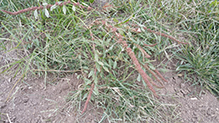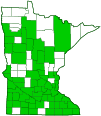rough-fruit amaranth
(Amaranthus tuberculatus)
Conservation • Weed • Wetland • Description • Habitat • Ecology • Use • Distribution • Taxonomy
Description |
||
Rough-fruit amaranth is a weedy annual forb that rises from a taproot. It can be from 8″ to 136″ tall, though in Minnesota it is usually no more than 60″ in height. The stems are usually ascending or erect, rarely lying flat on the ground (prostrate). They are frequently branched, hairless or nearly hairless, and green to yellowish-white or reddish-purple. They often have pink to purple longitudinal lines or ridges. They do not have spines at the nodes. The leaves are alternate and are variable in size and shape. They are on slender leaf stalks that are 3 ⁄16″ to 2″ long, one quarter to one half the length of the blade. The leaf blades are ¾″ to 6″ long, ⅜″ to 1¼″ wide. Lower leaves are egg-shaped to inversely egg-shaped, middle leaves oblong or elliptic, and upper leaves narrowly lance-shaped. They become progressively smaller and on shorter petioles as they ascend the stem. They are tapered or narrowed at the base and taper to a point at the tip with straight sides along the tip. Sometimes there is a small notch at the tip with a short, sharp, abrupt point in the notch. The upper and lower surfaces are hairless. The margins are untoothed and flat. The complete flowering system of plants in the Amaranthaceae family is called a synflorescence. It consists of a spike at the end of the plant (terminal inflorescence), a spike at the end of each branch, and single spikes rising from numerous upper leaf axils (axillary inflorescences). The terminal inflorescence is usually a single spike with numerous ascending branches (false panicle). An axillary inflorescence may be a long unbranched spike or a small, branched, false panicle of spikes. Each spike is narrow, linear, up to 12″ long, dense, and green. Occasionally the uppermost portion is interrupted, resulting in a group of dense, globe-shaped clusters that resembles a string of beads. Male (staminate) and female (pistillate) flowers are produced on different plants. Each flower is about ⅛″ (3 mm) long and is subtended by 1 to 3 modified leaves (bracts). The bracts are green to reddish-pink, narrowly lance- or egg-shaped, and 1 ⁄32″ to ⅛″ (1.0 to 2.5 mm) long, shorter or about as long as the sepals. They have wide papery margins and pointed tips. The midrib usually extends beyond the blade tip creating a short awn that is somewhat spine-like at maturity. Staminate flowers have 5 sepals, no petals, and 5 stamens. The sepals are green and 3 ⁄32″ to ⅛″ (2.2 to 3.0 mm) long. The outer two have short, awn-like extensions at the tip and strongly overlap the inner three. The stalks of the stamens (filaments) are free, not fused at the base. Pistillate flowers have 1 or 2 sepals or no sepals. The sepals, when present, are 1 ⁄64″ to 1 ⁄16″ (0.5 to 2.0 mm) long and have short, awn-like extensions at the tip. The style is very short and has 3 or 4 spreading stigmas. The fruit is an egg-shaped to almost dark brown to reddish brown, globe-shaped, 1 ⁄32″ to 1 ⁄16″ (1.5 to 2.0 mm) long, thin-walled bladder (utricle) with a single seed. It may release the seed at maturity by splitting cleanly around the middle (circumscissile) or by splitting along longitudinal seams (dehiscent). The seed is reddish-brown to black, shine, and about 1 ⁄16″ in diameter. |
||
Height |
||
8″ to 60″ |
||
Flower Color |
||
Green |
||
Similar Species |
||
Habitat |
||
Wet to moist. Edges of streams, rivers, ponds, lakes, and marshes; agricultural fields, roadsides, railroads, and other disturbed areas. Full or partial sun. |
||
Ecology |
||
Flowering |
||
July to September |
||
Pests and Diseases |
||
|
||
Use |
||
|
||
Distribution |
||||
|
Sources |
|||
| 4/29/2023 | ||||
Nativity |
||||
Native |
||||
Occurrence |
||||
Widespread from the East Coast to the Great Plains, and scattered populations in the far west. Common in Minnesota. |
||||
Taxonomy |
|||
| Kingdom | Plantae (Plants) | ||
| Subkingdom | Pteridobiotina | ||
| Phylum | Tracheophyta (Vascular Plants) | ||
| Class | Magnoliopsida (Dicots) | ||
Order |
Caryophyllales (Pinks, Cactuses, and Allies) | ||
Family |
Amaranthaceae (amaranths) | ||
| Subfamily | Amaranthoideae | ||
Genus |
Amaranthus (amaranths) | ||
Subgenus |
Acnida | ||
Subordinate Taxa |
|||
Rough-fruit amaranth is rarely found weakly ascending or lying flat on the ground with poorly developed terminal spikes. These were once classified as variety prostrata. It was later determined that these plants were germinated too late in the season for proper development to take place. Plants in the west differ from those in the east. They lack sepals (or have greatly reduced sepals) on the female flowers, and they have fruits that split open along seams at maturity (dehiscent). These were once (and occasionally still are) treated as a separate species, Amaranthus rudis. The two forms intergrade in the Midwest, and the intermediate plants were thought to be hybrids. A study in 2001 showed that there are an infinite number of gradations from east to west. In 2003, another study suggested that the two forms be treated as a single species, Amaranthus tuberculatus, and this has been widely though not universally accepted. Amaranthus species often occur in mixed species populations. When they do, they often cross-pollinate, creating hybrids. Rough-fruit amaranth is known to hybridize with redroot amaranth (A. retroflexus) and green amaranth (Amaranthus hybridus). The hybrids are sterile and have missing or shrunken flowers and fruits. |
|||
Synonyms |
|||
Acnida altissima Acnida altissima var. prostrata Acnida altissima var. subnuda Acnida concatenata Acnida subnuda Acnida tamariscina Acnida tamariscina var. prostrata Acnida tuberculata Amaranthus ambigens Amaranthus altissimus Amaranthus rudis Amaranthus tamariscinus Amaranthus tuberculatus var. prostratus Amaranthus tuberculatus var. rudis Amaranthus tuberculatus var. subnudus |
|||
Common Names |
|||
rough-fruit amaranth rough-fruit water-hemp rough-fruited amaranth roughfruit amaranth tall rough-fruit amaranth tall waterhemp tall water-hemp |
|||
Glossary
Bract
Modified leaf at the base of a flower stalk, flower cluster, or inflorescence.
Filament
On plants: The thread-like stalk of a stamen which supports the anther. On Lepidoptera: One of a pair of long, thin, fleshy extensions extending from the thorax, and sometimes also from the abdomen, of a caterpillar.
Linear
Long, straight, and narrow, with more or less parallel sides, like a blade of grass.
Panicle
A pyramidal inflorescence with a main stem and branches. Flowers on the lower, longer branches mature earlier than those on the shorter, upper ones.
Pistillate
Referring to a flower that has a female reproductive organ (pistil) but does not have male reproductive organs (stamens).
Prostrate
Laying flat on the ground.
Sepal
An outer floral leaf, usually green but sometimes colored, at the base of a flower.
Staminate
Referring to a flower that has a male reproductive organs (stamens) but does not have a female reproductive organ (pistil).
Utricle
A small, dry, inflated, thin-walled, bladder-like fruit containing one seed.
Visitor Photos |
|||||
Share your photo of this plant. |
|||||
| This button not working for you? Simply email us at info@MinnesotaSeasons.com. Attach one or more photos and, if you like, a caption. |
|||||
Thomas Metzenthin |
|||||
this grew in upturned soil in my parents yard. |
|||||
 |
|||||
MinnesotaSeasons.com Photos |
|||||
|
|||||

Slideshows |
||

Visitor Videos |
|||
Share your video of this plant. |
|||
| This button not working for you? Simply email us at info@MinnesotaSeasons.com. Attach a video, a YouTube link, or a cloud storage link. |
|||
Other Videos |
|||
| Amaranthaceae (Pigweed) Identification Ohio State University Weed Science |
|||
About
Published on May 6, 2016 Palmer amaranth, waterhemp, redroot/smooth pigweed identification |
|||
| Pigweed/Amaranth ID in Ohio Ohio State University Weed Science |
|||
About
Published on Mar 5, 2013 How to Identify various pigweed / amaranth species in Ohio Including redroot and smooth pigweed, palmer and powell amaranth, and common and tall waterhemp |
|||
| Weed ID: Waterhemp and Palmer Amaranth BASFAgproducts |
|||
About
Published on Apr 17, 2015 Waterhemp and Palmer amaranth are incredibly challenging weeds to control because they have the potential to grow up to two inches per day, robbing row crop plants of yield potential. While both weeds are commonly found in the southern U.S., they are rapidly being identified in many areas throughout the Midwest. Dr. Greg Armel of BASF shares tips on differentiating between the two weeds. Contact your local retailor or visit http://www.advancedweedcontrol.basf.us to learn more about weed management strategies. |
|||
| Weed of the Week #999 Waterhemp (Air Date 5-28-17) AgPhD |
|||
About
Published on May 31, 2017 Waterhemp is a problem across the country because of resistance. There are ways to control it. |
|||

Visitor Sightings |
|||||
Report a sighting of this plant. |
|||||
| This button not working for you? Simply email us at info@MinnesotaSeasons.com. Be sure to include a location. |
|||||
| Thomas Metzenthin 10/19/2018 |
Location: 750 Prigge, St. Louis, MO 63138 this grew in upturned soil in my parents yard. |
 |
|||
MinnesotaSeasons.com Sightings |
|||||

Created: 11/23/2018
Last Updated:
